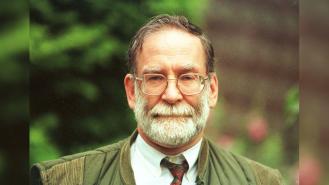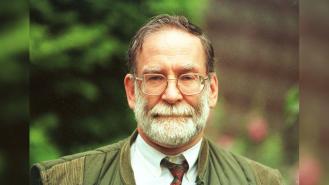
Charles Cullen: The killer nurse with an estimated 400 victims
'The good nurse'
For 16 years, Charles Cullen was employed as a nurse throughout various hospitals in New Jersey and Pennsylvania. Over that time, he slipped deadly overdoses of drugs into his patients’ IVs. It’s speculated that Cullen could have killed up to 400 patients, which would make him one of the world’s most prolific serial killers.
Cullen had quite a tumultuous childhood and he lost several family members throughout his youth. His father passed away when he was an infant before losing his mother while in high school. Two of his siblings also died not long after. For many years, he cared for his brother who ultimately lost a battle with cancer. (St. Louis Post-Dispatch, 18 December 2003 – ‘Death Has Surrounded Nurse Who is Accused of Poisoning Patients’)
After dropping out of high school, Cullen enrolled in the Navy and then attended Mountainside Hospital School of Nursing in Montclair. He graduated in 1987, got married and had two daughters.
In January of 1993, Cullen’s wife, Adrienne Taub, filed for divorce. She contacted the police and informed them that she was afraid of her husband. She revealed that he had previously spiked people’s drinks with lighter fluid and chillingly, he had once called a local funeral home to enquire about their rates. As he had access to drugs at the hospital where he worked she feared for her welfare and her two children. (The Morning Call, 28 May 2004 – ‘A Slide into Madness’)
In the domestic violence complaints filed by Taub, she detailed a series of incidents that had taken place at the couple’s home. Cullen had stuffed their pet ferret into a trash can, burned one of his daughter’s books in the fireplace, and on one occasion, dropped his daughters off with a babysitter and not picked them up for a week. According to Taub, she was forced to get rid of the family’s pets because she thought Cullen would kill them. She said that before these peculiar incidents, Cullen had never acted this way.
Taub had attempted to get a restraining order against Cullen, but the judge denied the request, stating that Cullen was guilty of ‘only odd behaviour, not threatening violence’.
In the wake of the divorce, Cullen’s life began to spiral out of control. He turned to alcohol to cope and desperately fought for custody of his two daughters, but to no avail. He attempted suicide several times, the first of which came just days after Taub made domestic violence complaints, and he battled with mounting financial problems and mental illness. Just two months after Taub filed for divorce, Cullen broke into the home of Michelle Tomlinson, a nurse. Afterwards, Taub would be granted a restraining order against Cullen.
Later that year, Cullen killed three of his patients at Warren Hospital in Phillipsburg, New Jersey. He gave fatal doses of the drug, digoxin, to Lucy Mugavero, Mary Natoli and Helen Dean. Before Dean died, she told family members that a male nurse had injected her with a needle and shortly thereafter, Cullen resigned from the hospital. The pathologist stated that Dean had died of cancer and a proper investigation was not launched.
From here, Cullen moved to Hunterdon Medical Center in Flemington, New Jersey where he mostly worked the night shifts. Over the next nine years, he moved to and from various hospitals across New Jersey, killing patients along his way. In some instances, he was fired, and in others, he left and moved elsewhere. Nobody was any the wiser due to a flawed regulatory system that did not allow information sharing among hospitals, combined with the silent death that comes with poisoning in a hospital setting.
Cullen attempted to take his own life on several more occasions, including one attempt in 2000 when he took a hibachi filled with charcoal into the bathtub with him, hoping the carbon monoxide inhalation would kill him. A woman who lived in the apartment above smelled smoke and contacted the police.
Suspicions were finally aroused in 2002 when a nurse at St. Luke’s contacted police to reveal her concern that he had been killing patients. She had a list of 69 patients who she feared he had killed. Local police spent nine months looking into Cullen but ultimately the investigation stalled; Cullen was never even interviewed.
Cullen wasn’t arrested until December of 2003 when officials at Somerset Medical Center noticed that an alarming number of patients had died with high levels of digoxin in their bodies. (NBC News, 2 March 2006 – ‘Nurse Who Killed 29 Sentenced to 11 Life Terms’) They fired Cullen after conducting an internal review which found a plethora of questionable lab results involving his patients. They then informed prosecutors of their findings and Cullen was placed under surveillance.
While under surveillance, police had Amy Loughren, who was a nurse at Somerset Medical Center, wear a wire and meet with Cullen. They spoke at a bar in Bridgewater, New Jersey, where Loughren confronted him about the suspicious deaths that had happened on his watch. (The Good Nurse: A True Story of Medicine, Madness and Murder by Charles Graeber)
Loughren attempted to extract a confession out of Cullen. “I know you did it. Let’s go to the police station. We can call them together,” she said. “I can’t, I can’t,” he replied, before leaving the bar. Investigators were waiting outside in the parking lot and the covert recording produced enough evidence for a probable cause of arrest.
Following Cullen’s arrest, he admitted to a plethora of murders, giving investigators an estimate of how many people he killed in each hospital. He was offered a plea agreement in which he avoided the death penalty in exchange for his confessions.
Cullen had used a variety of medications to fatally overdose his patients, including digoxin, insulin, dobutamine, nitroprusside, norepinephrine, and pavulon. (The Morning Call, 30 April 2004 – ‘He’s As Cold As Ice’) Some of his victims survived the initial overdose, leading Cullen to try repeatedly and even change the lethal medications to finish the job. (The Morning Call, 15 October 2004 – ‘Cullen was Persistent’) He admitted to roaming the units to find a potential victim; he scanned medical charts to find patients who were in for multiple organ failure and those who had a “do not resuscitate” order.
He appeared in court and pled guilty to 22 murders and three attempted murders in New Jersey. During his time in court, Cullen refused to look at the families of the victims, often pretending to be asleep at the defendant’s table. “You don’t even have the guts to look this way, do you? That’s a shame,” said the son of one of his victims. Cullen was sentenced to 11 consecutive life terms and he later confessed to an additional seven murders and three attempted murders in Pennsylvania. (The Philadelphia Inquirer, 3 March 2006 – ‘Demon From Lowest Depths’)
While only 29 murders could be confirmed, Cullen claimed that he killed up to 40 people during his nursing career, which spanned over 16 years. Investigators, however, believe that the number could be much higher, possibly even around the 400 mark.
As for motivation, Cullen rationalized that he was ending the suffering and preventing the dehumanization of his victims. “Mercy killing is a common defence,” said Dr. Michael Welner, a psychiatric teacher at New York University Center. “But that is a rationalization a person employs to convince themselves they’re doing the right thing.” However, not all of Cullen’s victims were terminally ill; one was only 21 and had been in hospital for a routine spleen surgery.
As the daughter of one of his victims stated after Cullen was sentenced: “He was supposedly some sort of angel of mercy, ending peoples’ suffering. Well, he should look around the courtroom.”
5 facts about Charles Cullen
Carrying out countless murders over a long career as a seemingly impeccable nurse, Charles Cullen is one of the most insidious serial killers of all time. Here are some key facts about this unassuming medical murderer.
1. He was troubled from a young age
The youngest of eight children, Cullen had a deeply unhappy childhood bookended by the deaths of his father (when Cullen was an infant) and mother (in a car accident when he was 17). A bullied misfit, he attempted to kill himself at least twice during his younger years, with the sudden loss of his mother being a particularly traumatic experience.
Joining the US Navy didn’t help matters. Serving as a missile technician on a nuclear submarine, Cullen felt ostracised and bullied by his crewmates. He was also known for his strange behaviour – including manning the controls of one submarine while wearing a surgical mask and hospital gown, for reasons unknown.
2. It’s believed his depressive state fuelled the murders
Many experts believe that Cullen’s depressive, suicidal state of mind – exacerbated by the dramatic breakdown of his marriage and family unit – gave him a sense of aggrieved victimhood which propelled him on the path to murder.
Speaking about the case to 60 Minutes, Charles Graeber – author of The Good Nurse: A True Story of Medicine, Madness and Murder – said: ‘It was never about anybody but Charlie Cullen… He sees himself as a victim, and as a victim, he’s entitled to lash out in any way he wants to make things right… If the rest of his life was spinning out of control, if he was losing custody, if he was feeling depressed, if his love life was in the toilet, he could poison patients, he could save patients, he had an arena in which he mattered.’
3. There were numerous chances to stop him
Unlike many other serial killers who slip completely under people’s radars, Cullen was widely seen as a potentially criminal liability from the start of his nursing career. There was even an investigation into contaminated IV bags at Saint Barnabas, the hospital where Cullen first started killing patients, but he was able to move to another job without anyone raising the alarm.
As Charles Graeber has said, ‘He was the main suspect… If you talk to the investigators there, they’ll tell you, "Cullen was our man, we knew he was dirty”. They couldn’t prove anything. It’s all circumstantial.’
Even Cullen, speaking in a prison interview, said that the authorities at Saint Barnabas had grounds to revoke his licence. A combination of systematic failings, with hospitals failing to speak to each other and look into Cullen’s track record, together with a nursing shortage and a fear of being sued by patients meant he was able to move from job to job, killing as he went.
4. He exploited software to commit his killings
Cullen utilised several drugs, notably the cardiac medicine digoxin, to murder patients with impunity. He did this by exploiting a vulnerability in the technology used by staff to obtain the required medications. Called Pyxis, it functions as a kind of cash till for drugs, with clinicians tapping in what drugs they need and the drawer popping open to provide access to the pills and liquids.
Technically, Pyxis should have flagged up the fact that Cullen was obtaining suspiciously high doses of digoxin and other medications. However, he’d realised that the drawer would pop open even if he immediately cancelled an order, meaning he could take the meds without leaving an obvious digital trail. He eventually altered his approach by ordering innocuous drugs, like painkillers, knowing they resided in the same drawer as digoxin.
5. A fellow nurse was key to catching him
After years of vague and circumstantial concerns, Cullen was finally apprehended thanks to the brave cooperation of a fellow nurse, and friend of Cullen’s, named Amy Loughren. Approached by detectives who were desperate for a hospital insider to help them, she analysed Pyxis records and quickly realised what Cullen had been up to. Feeling betrayed, she agreed to wear a wire while presenting her suspicions to Cullen. This audio surveillance led to Cullen’s arrest and eventual confession.
The Good Nurse: Cullen on film
The Cullen case was first adapted into a 2008 film called Killer Nurse, which was widely panned for conveying almost nothing of the real story and falsely portraying Cullen as a sexually motivated killer.
Then, in 2022, came The Good Nurse, based on Charles Graeber’s book. It stars Eddie Redmayne, who, as well as bearing a close physical resemblance to Cullen, also perfectly replicated the killer’s hesitant, softly-spoken manner. Jessica Chastain brought raw emotional intensity in the role of Amy Loughren, whose friendship with Cullen would seal his fate.
The film sticks very closely to the real details of the case, including the fact that Amy had to hide a serious heart condition from her hospital colleagues because she didn’t want to lose her job. The film also presents two real-life heroes, detectives Danny Baldwin and Tim Braun, whose dogged persistence in the face of hospital stonewalling led to Cullen’s eventual capture.
Indeed, the film focuses less on the grisly details of the murders and more on how the police investigation revealed the shocking failings of healthcare managers. In the words of director Tobias Lindholm: ‘Why he did it is not as interesting a question as how he was allowed to continue to do it. For me, that was the most frightening question. Understanding that somebody could have stopped him but didn’t, for profit, that was where I could feel the burning in my soul. That particular why is the reason for this film.’











